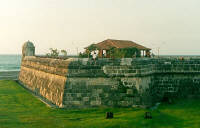I went to Cartagena because Brian told me so. No one had spoken more impressively, more exquisitely about any other city in the world. He was English who had traveled in the opposite direction to mine, starting in Tierra del Fuego, in the southern cone of South America, moving along the Andes, descending to the Amazon, and lounging lazily on the Caribbean.
When our paths crossed for a brief two hours in Tica Linda before my departure for Panama City, Brian spoke with polished and earnest words about his experience in the south. We sat at the table, looking over a map of South America. He jotted down dozens and dozens of exotic names, putting exclamation marks by those that deserved my particular attention. I watched him with my enchanted eyes, following his every move, stress in his voice, and glimmer in his eyes. That evening, as I awaited my bus, Brian told me about Cartagena de las Indias in Colombia (map). The name rang in my ears all night long…I decided to go there at the nearest opportunity.

Cartagena stands for the quintessence of Latin culture and could be a smart compression of nearly everything you might have ever fancied about Latin America. The walls surrounding the city loom over the southern Caribbean Sea, testifying to the Golden Age of the Spanish Empire.
Today, instead of the English pirate ships beseeching the city, you can spot enormous cruise ships mooring safely in the city’s harbor. Tourists flock to Cartagena by hundreds, lured by the city’s legendary appeal. Most of them ignore the US Department of State’s annual warnings to stay away from Colombia on account of the ongoing war between the regional rebels and the government. But then only a handful, if none, will ever venture beyond Cartagena.
People are afraid of traveling in Colombia but you shouldn’t. More then anything, you will find most of the country, with certain areas off limits, an ideal place for independent traveling. Be aware, though, that Colombia bears a devil inside. No matter how careful you are, you will feel and taste the devil’s fiery embrace sooner or later.
Cartagena was my gateway to South America through which I learned my ABC of Latin culture. I still remember my first encounter face to face with this magic city as if it had happened yesterday. It was a later afternoon and I had just wandered in from the airport to Hotel Familiar, my shabby clothes soaked with sweat. The sun leaned toward the horizon when I set out hurriedly to explore the city. A quick walk along la Avenida de la Media Luna to the Parque del Centenario and I paused at the Clock Tower, one of the Old City’s gates. The walls looked imposing and nearly magical.
To my knowledge, Cartagena is one of the unique cities in the world where the complete fortifications dating back to the XVI century still stand intact. Their massive contours testify to the importance that the Spaniards attached to the city as the guardian of their interests in the New World. The English attempted to subdue the port on many occasions, only driving the Spanish to reinforce the walls after each attack.

Inside, the city continued to flourish against all its odds and turbulence, accommodating magnificent town houses and cathedrals. It is great to pass time strolling along the walls at the sundown, watching the glittering ripples of the Caribbean Sea diminish with the setting sun. You might even find a comfortable repose upon one of the remaining cannons still pointing to the invisible enemy at sea.
Stepping inside the Old City can be a transforming experience if you keep your senses rightly attuned. There are quarters after quarters of ancient colonial buildings and houses in diverse conditions, nonetheless all outstanding in their character and charm. An old, even neglected, image of the townhouses can have, in fact, a moving effect upon your senses. Some houses catch an eye with large chunks of paint hanging loose, others look ghastly with numerous cracks intersecting the walls like a spider web.
However, behind such a superficial negligence emerges the very essence of Cartagena’s beauty. The scent of old age, blended with the intense odor of flowers that pour down into the streets from the wooden, colonial balconies, can transform a visitor. Add to this a mixture of thick humidity present all year around and the cooling shades cast by the palm trees, and you will not want to leave.
Read the whole adventure!
Part One
Part Two
Part Three